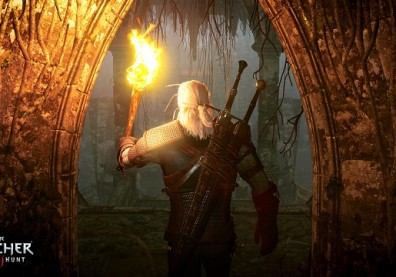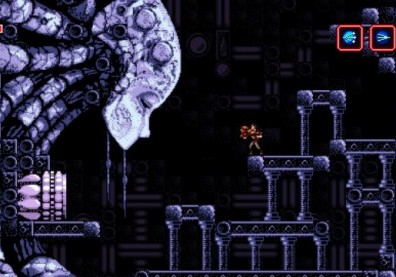Retro games are nothing new, but there seems to be a recent resurgence of games that really want to take things back to the way they were. Not content just to to utilize pixel art like so many games before them, they seek to replicate the entire gameplay experience, from the chiptune music and limited color palette to the way the 8 and 18-bit games of yore played, even down to their limitations. Axiom Verge is perhaps the best example of this yet, providing the experience of an NES title all the way down to its visual glitches, which here can be manipulated in order to change the game world.
In the way that Shovel Knight was influenced by Mega Man, Axiom Verge is influenced by Metroid. Influenced is perhaps too soft a word- the game has almost direct send-ups of enemies, art, the music style, and even uses one of the game’s best-known secret codes in a really clever way. There's no hiding the game's legacy.
In it you play a scientist whose experiment blows up in his face, the way they often do, and is transported into a strange 2D world full of alien life forms and ghostly voices talking to him. You’ll start to load up on weapons and fight bosses, much as you’d expect from the game style. You’ve got a little map in the top right corner and you’re going to want to fill it all in, exploring a massive alien world and killing anything that moves.
You’ll find pretty much everything here that you’d expect from the style- power-ups that let you jump higher and explore new areas, health and power-ups scattered everywhere, even a clever little way of turning into a ball and getting into smaller cracks. An eventual drill upgrade lets you find breakable blocks in the environment and open up every area of the map that you can, while the a tool called the Address Disruptor lets you manipulate the before-mentioned glitches or even create your own. (Any enemy can be hit with this to turn into a different NES-style sprite glitch, which is both visually fascinating and useful.)
There’s a huge amount of weapons to play with too, although you’ll start with the standard Axiom Disruptor, which shoots a single projectile and can be upgraded. You'll eventually find others that offer things like a shotgun-type blast, an energy burst that can be detonated for huge damage, and a lightning gun. You can easily swap between all of these with the right stick and you'll need as many as you can find to take on the numerous bosses, the fights always indicated by an ominous red door.
A deeper story awaits anyone who seeks out the many journals hidden around the world, but Axiom Verge can be considered old school to a fault. No checkpoints, no indication of where to go means that gamers will have to learn to once again explore the map and find new areas on their own, rather than have a blinking waypoint showing them exactly where to go and what to do. There's no fast travel- if you want to explore the other side of the map, you better get to walking. That can lead to you exploring the world for hours between bosses, trying to figure out just what new places you can access with your new-found powers. Whether that’s a bad thing or not will depend on the gamer, of course, as the more hand-held modern gamer might get frustrated over the lack of direction. Those who miss exploring a world at their own whim will be in heaven, however.
Unlike other games which feature a little bit of roguelike flavor (I’m staring your way, Chasm) you won’t lose your progress after death- you’ll just return to the last pod where you regenerated, save points which are liberally placed around the environment. It makes it so it’s never that hard or frustrating, even though some of the secret areas will truly test your skills.
(This is, though, one of the few games that ever questions this form of rebirth. Are you still you after emerging from the pod for the dozenth time? Are you dying every time? Who are you now, really?)
One thing you might be stunned to find out is that this is the work of a lone developer, one Tom Happ, who created everything from the graphics to the wonderful soundtrack over the course of five years, working on it part-time until Sony stepped up to help fund it a year ago. It’s a sprawling world and to get everything at place would have been an incredible achievement even with a team in place.
While it’s a more worthy successor to Metroid than Metroid: Other M, it really doesn’t do much of its own thing. There are no real surprises here for connoisseurs of the style, and while each new tool and weapon you get to play with is a joy, it’s all stuff we’ve seen in other games before. The idea of utilizing glitches to move around the environment or more easily take on enemies is a clever one, but it never feels fully fleshed out. But does that matter when the game is such a blast to play? Likely not.
Axiom Verge is so well-crafted that it absolutely belongs in your library, providing plenty of nostalgia flashbacks for old-school Metroid fans and a thorough lesson of what the new generation of gamers are currently missing.
----
Axiom Verge was reviewed from an early PS4 code, and it’s also on the way to Vita (with cross-buy support) and PC. It’s available at 10% off its $19.99 price this week for PS Plus members, and they’re promising that they’ll let you know about any upcoming sales months in advance so you’ll never be taken by surprise, with no sales at all happening for at least six months.









